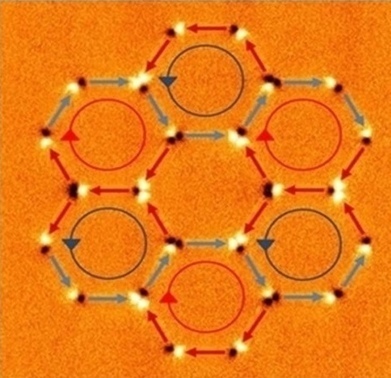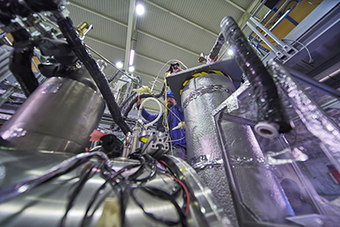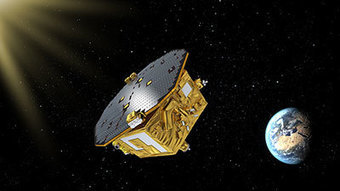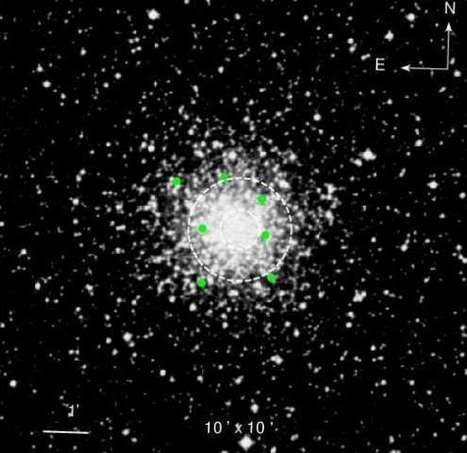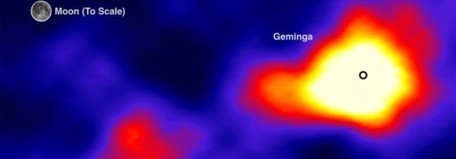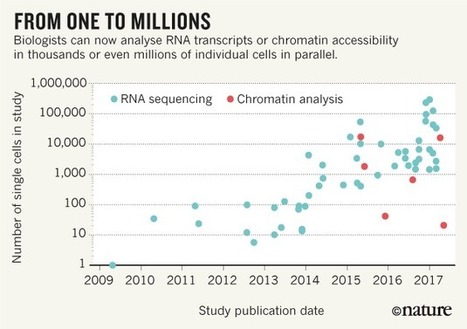 Your new post is loading...
Researchers have used a simple inkjet printer to print a "bio-ink" of cyanobacteria onto a conductive surface, creating a biophotovoltaic cell. Unlike conventional photovoltaic cells that operate only when exposed to light, the cyanobacteria can generate an electric current both in the dark and in response to light. The researchers expect that the cell may serve as an environmentally friendly power supply for low-power devices such as biosensors, and can even be scaled up to print a bioenergy wallpaper.
The scientists, at Imperial College London and University of Cambridge, have published a paper on the new biophotovoltaic cell in a recent issue of Nature Communications. "Our biophotovoltaic device is biodegradable and in the future could serve as a disposable solar panel and battery that can decompose in our composts or gardens," coauthor Marin Sawa at University of Arts London and Imperial College London told Phys.org. "Cheap, accessible, environmentally friendly, biodegradable batteries without any heavy metals and plastics—this is what we and our environment really need but don't have just yet, and our work has shown that it is possible to have that." In general, biophotovoltaic cells contain some type of cyanobacteria or algae that is phototrophic, meaning it converts light into energy. However, even in the dark these organisms continue to generate some energy by metabolizing their internal storage reserves. So when the organisms are connected to a non-biological electrode, they can function as either a "bio solar panel" when exposed to light or a "solar bio-battery" in the dark. Currently one of the biggest challenges facing biophotovoltaic cells is producing them on a large scale. Typically, the organisms are deposited onto an electrode surface from a bulky liquid reservoir. In the new study, the researchers demonstrated that inkjet printing can be used to print both the carbon nanotube electrode surface and the cyanobacteria on top of it, while allowing the bacteria to remain fully viable. This approach not only allows the cells to be fabricated quickly, but the set-up is also more compact and allows for greater precision in cell design. With these advantages, the inkjet-printed biophotovoltaic cells can generate a maximum current density that is 3-4 times higher than cells fabricated using conventional methods. To demonstrate, the researchers showed that nine connected cells can power a digital clock or generate flashes of light from an LED, illustrating the ability to produce short bursts of relatively high power. The researchers also showed that the cells can generate a continuous power output over the course of a 100-hour period consisting of light and dark cycles. In the future, the researchers plan to develop thin-film biophotovoltaic (BPV) panels and also explore potential applications as integrated power supplies in the areas of point-of-care medical diagnostics and environmental monitoring, both of which benefit from disposable, environmentally friendly biosensors. Another potential application is a bioenergy wallpaper. "The bioenergy wallpaper is a scaled-up application of our BPV system," Sawa said. "The wallpaper will have carbon-based conductive patterns with electron-producing cyanobacteria. It turns an interior surface into an energy harvester to drive low-power applications like LED lights and/or biosensors, which can, for example, monitor indoor air quality."
Via Mariaschnee
Researchers recently discovered what was thought to be a distinct species of butterfly is actually the female of a species known to science for more than a century. An international team of nine butterfly researchers from the U.S., Brazil, the U.K., Peru and Germany used DNA sequence data to associate the female sunburst cerulean-satyr, or Caeruleuptychia helios, an Amazonian brush-footed butterfly, with its male counterpart. Males and females of this group look dramatically different from each other, a phenomenon known as sexual dimorphism, and the species was named and described in 1911 based on the brilliantly iridescent blue males. Rarer than the male, the brown female was considered another species and was recently named and placed in a different genus, Magneuptychia keltoumae. A study correcting the classification error was published today in Insect Systematics and Evolution. "Our study will serve as the basis for developing a firm understanding of true species diversity of this group and of Neotropical butterflies in general," said Shinichi Nakahara, the study's lead author and a research associate at the Florida Museum of Natural History's McGuire Center for Lepidoptera and Biodiversity at the University of Florida. "These findings are extremely valuable at a time when the biodiversity of the Neotropics is threatened since it will be impossible to recognize and document the region's unique elements of biodiversity after they are gone." As part of the project, DNA bar codes—short, diagnostic gene sequences—were collected and analyzed for more than 300 species across the euptychiines group of butterflies.
Life on Earth might have originated from tiny organisms brought to our planet in streams of fast-moving space dust, according to a new study. Fast-moving flows of interplanetary dust that continually bombard our planet's atmosphere could deliver tiny organisms from far-off worlds, or send Earth-based organisms to other planets, according to the research. The dust streams could collide with biological particles in Earth's atmosphere with enough energy to knock them into space, a scientist has suggested. Such an event could enable bacteria and other forms of life to make their way from one planet in the solar system to another and perhaps beyond. The finding suggests that large asteroid impacts may not be the sole mechanism by which life could transfer between planets, as was previously thought. The research from the University of Edinburgh calculated how powerful flows of space dust -- which can move at up to 70 km a second -- could collide with particles in our atmospheric system. It found that small particles existing at 150 km or higher above Earth's surface could be knocked beyond the limit of Earth's gravity by space dust and eventually reach other planets. The same mechanism could enable the exchange of atmospheric particles between distant planets. Some bacteria, plants and small animals called tardigrades are known to be able to survive in space, so it is possible that such organisms -- if present in Earth's upper atmosphere -- might collide with fast-moving space dust and withstand a journey to another planet. The study, published in Astrobiology, was partly funded by the Science and Technology Facilities Council. Professor Arjun Berera, from the University of Edinburgh's School of Physics and Astronomy, who led the study, said: "The proposition that space dust collisions could propel organisms over enormous distances between planets raises some exciting prospects of how life and the atmospheres of planets originated. The streaming of fast space dust is found throughout planetary systems and could be a common factor in proliferating life."
Researchers have shown how to write any magnetic pattern desired onto nanowires, which could help computers mimic how the brain processes information. Much current computer hardware, such as hard drives, use magnetic memory devices. These rely on magnetic states -- the direction microscopic magnets are pointing -- to encode and read information. Exotic magnetic states -- such as a point where three south poles meet -- represent complex systems. These may act in a similar way to many complex systems found in nature, such as the way our brains process information. Computing systems that are designed to process information in similar ways to our brains are known as 'neural networks'. There are already powerful software-based neural networks -- for example one recently beat the human champion at the game 'Go' -- but their efficiency is limited as they run on conventional computer hardware. Now, researchers from Imperial College London have devised a method for writing magnetic information in any pattern desired, using a very small magnetic probe called a magnetic force microscope. With this new writing method, arrays of magnetic nanowires may be able to function as hardware neural networks -- potentially more powerful and efficient than software-based approaches. The team, from the Departments of Physics and Materials at Imperial, demonstrated their system by writing patterns that have never been seen before. They published their results today in Nature Nanotechnology. Dr Jack Gartside, first author from the Department of Physics, said: "With this new writing method, we open up research into 'training' these magnetic nanowires to solve useful problems. If successful, this will bring hardware neural networks a step closer to reality." As well as applications in computing, the method could be used to study fundamental aspects of complex systems, by creating magnetic states that are far from optimal (such as three south poles together) and seeing how the system responds.
Apple is investigating multiple ways virtual and augmented reality could be implemented into future iOS devices or new hardware products. Apple has been exploring virtual reality and augmented reality technologies for more than 10 years based on patent filings, but with virtual and augmented reality exploding in popularity with the launch of ARKit, Apple's dabbling may be growing more serious and could lead to an actual dedicated AR/VR product in the not-too-distant future. Apple is rumored to have a secret research unit comprising hundreds of employees working on AR and VR, exploring ways the emerging technologies could be used in future Apple products. VR/AR hiring has ramped up and Apple has acquiredmultiple AR/VR companies, suggesting something is afoot in Cupertino. There are dozens of possibilities for VR/AR technology in Apple products, and in 2017, Apple is betting big on both AR and VR. VR support is included in Metal 2 in macOS High Sierra, and in iOS 11, Apple has developed an ARKit API that lets developers create impressive AR-based apps and games with little effort. Along with software support for AR/VR, Apple is said to be working on hardware, with the focus currently on an augmented reality headset or "smart glasses." According to rumors, Apple is developing on an augmented reality headset with a dedicated display, a built-in processor, and a new "rOS" or reality operating system. rOS is said to be based on iOS, the operating system that runs on the iPhone. For the AR headset, Apple is developing a "system-on-a-package" chip similar to what's in the Apple Watch. As for input methods, Apple is considering touch panels, voice activation, and head gestures, and a range of applications from mapping to texting are being prototyped. Virtual meeting rooms and 360-degree video playback are also concepts that are being explored. As Apple prepares to launch its new AR headset, the company will introduce a new version of ARKit for developers, perhaps as soon as 2018. The new ARKit will be used to make AR games for multiple players and it will reportedly introduce persistent tracking, aka a feature that remembers where a digital object was placed in a virtual space. Apple may actually be experimenting with several augmented reality headset prototypes as engineers search for the "most compelling application" for such a device. At least one group at Apple is pushing for glasses that feature a 3D camera but no screen, similar to Snap's Spectacles. Apple is aiming to finish work on its augmented reality headset by 2019, and a finished product could be ready to ship as soon as 2020. Apple's timeline is said to be "very aggressive," though, and could change, but the hardware still has a few years of development to go.
To understand puns, the left and right brain hemispheres have to work together. Puns are divisive in comedy. Critics groan that they are the “lowest form of wit,” a quote attributed to various writers. Others—including Shakespeare—pun with abandon. The brain itself seems divided over puns, according to a recent study published in Laterality: Asymmetries of Body, Brain and Cognition. The results suggest the left and right hemispheres play different roles in processing puns, ultimately requiring communication between them for the joke to land. To observe how the brain handles this type of humor, researchers at the University of Windsor in Ontario presented study participants with a word relating to a pun in either the left or right visual field (which corresponds to the right or left brain hemisphere, respectively). They then analyzed a subject's reaction time in each situation to determine which hemisphere was dominant. “The left hemisphere is the linguistic hemisphere, so it's the one that processes most of the language aspects of the pun, with the right hemisphere kicking in a bit later” to reveal the word's dual meanings, explains Lori Buchanan, a psychology professor and co-author of the study. This interaction enables us to “get” the joke because puns, as a form of word play, complete humor's basic formula: expectation plus incongruity equals laughter. In puns—where words have multiple, ambiguous meanings—the sentence context primes us to interpret a word in a specific way, an operation that occurs in the left hemisphere. Humor emerges when the right hemisphere subsequently clues us in to the word's other, unanticipated meaning, triggering what Buchanan calls a “surprise reinterpretation.”
This is the first example of speciation that scientists have been able to observe directly in the field. Researchers followed the entire population of finches on a tiny Galapagos island called Daphne Major, for many years, and so they were able to watch the speciation in progress. The research was published in the journal Science. The group of finch species to which the Big Bird population belongs are collectively known as Darwin's finches and helped Charles Darwin to uncover the process of evolution by natural selection. In 1981, the researchers noticed the arrival of a male of a non-native species, the large cactus finch. Professors Rosemary and Peter Grant noticed that this male proceeded to mate with a female of one of the local species, a medium ground finch, producing fertile young. Almost 40 years later, the progeny of that original mating are still being observed, and number around 30 individuals. "It's an extreme case of something we're coming to realise more generally over the years. Evolution in general can happen very quickly," said Prof Roger Butlin, a speciation expert who wasn't involved in the study.
A new measurement technique used by CERN's BASE collaboration has constrained the magnetic moment of the antiproton with parts-per-billion precision – a huge improvement over the roughly one-part-per-million precision achieved by the same team in January. The result means that the magnetic moment of the antiproton is now known even more precisely than the magnetic moment of the proton itself. Crucial to the 350-fold improvement in precision was the simultaneous measurement of the cyclotron frequency of one antiproton and of the Larmor frequency of another antiproton. By using a "hot" particle in the cyclotron measurement, the researchers avoided the need for a time-consuming cooling step in each cycle of their experiment. This allowed the team to make measurements at a much greater rate than before, and three times faster than they managed when they measured the proton's magnetic moment in 2014. Equal and oppositeDiscrepancies between the properties of protons and antiprotons could explain the overwhelming dominance of normal matter in the universe – something that is not explained by the Standard Model of particle physics. Anybody hoping for hints of new physics beyond the Standard Model will be disappointed, however, because the result is consistent with protons and antiprotons having magnetic moments that are opposite but equal. The researchers expect to achieve a further improvement in precision by upgrading the experiment's magnetic shielding and cooling system, and by using a more homogeneous magnetic field in the precision trap. The experiment is described in Nature.
Atom interferometers could be more effective than light-based instruments in detecting gravitational waves. Gravitational waves hit the headlines in February last year when the LIGO collaboration announced it had detected them directly for the first time using a pair of huge laser interferometers in the US. With a further five sightings reported since then by LIGO and its European counterpart Virgo, scientists have begun to open what they call a new window on the universe. Now, keen to open that window as wide as possible, several groups have proposed sending atomic interferometers into space to observe gravitational waves that are difficult to intercept on the ground. Gravitational waves are ripples in space–time that create tiny periodic expansions and contractions of space along orthogonal axes as they propagate forward. And, like any waves, they come in a range of frequencies. LIGO, which stands for the Laser Interferometer Gravitational-wave Observatory, detects them by monitoring a change in the relative phase of two perpendicular laser beams. However, at frequencies below about 10 Hz, this signal tends to be drowned out by terrestrial sources of noise, such as seismic waves. To avoid such interference and detect low-frequency waves, physicists are eager to launch interferometers into the quiet of space. The €1.5 Billion Laser Interferometer Space Antenna (LISA) would consist of three spacecraft positioned millions of kilometers apart in a triangular formation, and would detect gravitational waves by monitoring the interference between laser beams bounced back and forth off free-floating test masses inside each spacecraft. First proposed about 25 years ago, the project has suffered a series of funding problems and was only officially inserted into the European Space Agency’s science program in June this year, following the successful completion of its predecessor LISA Pathfinder. Its launch is planned for 2034.
Researchers have presented a chemical study of the old, metal-rich globular cluster NGC 5927. The new research determines abundances of 22 elements in seven giant stars of the cluster. Discovered in 1826, NGC 5927 is a globular cluster near the Galactic plane, located about 7,700 light years from the Earth. It is one of most metal-rich globular clusters in the Milky Way and has an estimated age of approximately 12.25 billion years. Galactic globular clusters, especially such old as NGC 5927, are important for astronomers since they are among the oldest objects in the universe. Therefore, they could serve as natural laboratories for the study of stellar evolution processes. In the case of NGC 5927, it is believed that it was formed during the earliest stages of the formation of the Milky Way. Hence, researchers hope that this cluster could provide essential information about how the initial material got processed chemically. A team of astronomers led by Aldo Mura-Guzman of the University of Concepción in Chile, has lately performed a chemical study of NGC 5927. They obtained high-resolution spectra using the FLAMES/UVES spectrograph at the UT2 telescope of the European Southern Observatory (ESO) in Chile, which allowed them to conduct a detailed chemical abundances analysis of this cluster. "In this paper we present a chemical study of the GC NGC 5927 based on high-resolution spectra taken from UVES," the authors wrote in the paper. The researchers determined chemical abundances 22 such as sodium, aluminum, iron, oxygen and heavy elements like yttrium and zirconium. They found that NGC 5927 hosts multiple stellar populations with oxygen-sodium anti-correlation, and moderate spread in aluminum abundances. According to the paper, NGC 5927 has a mean metallicity of –0.47 dex, what is consistent with previous studies. This value is comparable with field stars and globular clusters in the Milky Way's bulge. Moreover, the scientists noted that no significant spread in other iron-peak elements is visible in the studied cluster. Furthermore, the researchers confirmed a sodium-aluminum correlation but found no clear evidence for magnesium-aluminum anti-correlation in NGC 5927.
Scientists aren't sure why so much antimatter is hitting Earth. New observations at the High-Altitude Water Cherenkov Gamma-Ray Observatory may offer an answer. The Earth is constantly being hit by cosmic rays, but scientists have noticed an unusually large amount of high-energy positrons – the antimatter counterparts of electrons. Now a group of researchers from the United States, Mexico, Germany, and Poland might have an explanation. According to the Institute of Nuclear Physics Polish Academy of Sciences (IFJ PAN), the excess positrons might be “the first particles recorded by humans to be derived from the interaction of dark matter.”
Less than 0.05 percent of the ocean floor has been mapped to a level of detail useful for detecting items such as airplane wreckage or the spires of undersea volcanic vents Unlike mapping the land, we can’t measure the landscape of the sea floor directly from satellites using radar, because sea water blocks those radio waves. But satellites can use radar to measure the height of the sea’s surface very accurately. And if there are enough measurements to subtract the effects of waves and tides, satellites can actually measure bumps and dips in the sea surface that result from the underlying landscape of the ocean floor. Where there’s a large underwater mountain or ridge, for example, the tiny local increase in gravity resulting from its mass pulls sea water into a slight bump above it. If instead there is an ocean trench, the weaker local gravity produces a comparative dip in the ocean surface. Reading those bumps and dips in the sea’s surface is an astounding feat of precision measurement, involving lasers to track the trajectory of the measuring satellite and inevitably a lot of maths to process the data. The new map uses data from the Cryosat-2 and Jason-1 satellites and shows features not seen in earlier maps using data from older satellites. The previous global map of the ocean floor, created using the same techniques and published in 1997, had a resolution of about 20km. So we do actually have a map of 100% of the ocean floor to a resolution of around 5km. From that, we can see the main features of its hidden landscape, such as the mid-ocean ridges and ocean trenches – and, in that sense, the ocean floor is certainly not “95% unexplored”. But that global map of the ocean floor is admittedly less detailed than maps of Mars, the Moon, or Venus, because of our planet’s watery veil. NASA’s Magellan spacecraft mapped 98% of the surface of Venus to a resolution of around 100 meters. The entire Martian surface has also been mapped at that resolution and just over 60% of the Red Planet has now been mapped at around 20m resolution. Meanwhile, selenographers have mapped all of the lunar surface at around 100 meter resolution and now even at seven meter resolution.
Physicists have demonstrated that two independently developed concepts—quantum coherence and the nonclassicality of light—both arise from the same underlying resources. The ability to explain seemingly distinct phenomena within a single framework has long been a fulfilling aspiration in physics, and here it may also have potential applications for quantum information technologies.
The physicists, Kok Chuan Tan, Tyler Volkoff, Hyukjoon Kwon, and Hyunseok Jeong, at Seoul National University, have published a paper on their work in a recent issue of Physical Review Letters. "The results unify two well-known yet independently developed notions inquantum information theory and quantum optics: the concept of quantumcoherence that was recently developed based on the framework of quantum resource theories, and the notion of nonclassicality of light that has been established since the 1960s based on the quantum theory of light," Jeong explains.
As Jeong stated, an important question in physics is how to draw the line between "quantum" and "classical" and how to quantify the degree of "quantum." In their new work, the physicists developed a procedure that quantifies the amount of coherence in a superposition of coherent states. This information essentially tells how "quantum" vs. how "classical" these states are, which is useful for many quantum information tasks. In the process of doing this, the scientists found that the same resource that measures coherence can also be used to measure the nonclassicality of light. This finding helps to explain some previous observations, such as that both coherence and nonclassical light can be converted to quantum entanglement. As the new results show, this is because nonclassical light may be interpreted as a form of coherence. "I think it is always interesting to apply new ideas to old concepts to see if we can get additional insight," Tan said. "In this case, the resource theory of coherence is a relatively new tool available to the community while nonclassical light is, comparatively speaking, a much older concept from a mature field of study. By providing a connection between the two concepts, our hope is to be able to create synergy, where the tools and insights we gain from coherence can be used to achieve greater insight into the inner workings of nonclassical light and vice versa. For instance, our work suggests that the fact that both coherence and nonclassical light can both be converted to entanglement is no mere accident."
Via Mariaschnee
|
’Omics bashing is in fashion. In the past year, The New York Times and The Wall Street Journalhave run pieces poking fun at the proliferation of scientific words ending in -ome, which now number in the thousands. One scientist has created a badomics generator, which randomly adds the suffix to a list of biological terms and generates eerily plausible titles for scientific papers (example: ‘Sequencing the bacteriostaticome reveals insights into evolution and the environment’). Jonathan Eisen, a microbiologist at the University of California, Davis, regularly announces awards for unnecessary additions to the scientific vocabulary on his blog (recent winner: CircadiOmics, for genes involved in daily circadian rhythms). Take the ’omics challenge: download our ’ome crossword. Botanist Hans Winkler had no idea what he was starting back in 1920, when he proposed the term ‘genome’ to refer to a set of chromosomes. Other ’omes existed even then, such as biome (collection of living things) and rhizome (system of roots), many of them based on the Greek suffix ‘-ome’ — meaning, roughly, ‘having the nature of’. But it was the glamorization of ‘genome’ by megabuck initiatives such as the Human Genome Project that really set the trend in motion, says Alexa McCray, a linguist and medical informatician at Harvard Medical School in Boston, Massachusetts. “By virtue of that suffix, you are saying that you are part of a brand new exciting science.” Researchers also recognize the marketing potential of an inspirational syllable, says Eisen. “People are saying that it’s its own field and that it deserves its own funding agency,” he says. But although some ’omes raise an eyebrow — museomics (sequencing projects on archived samples) and the tongue-in-cheek ciliomics (study of the wriggling hairlike projections on some cells) — scientists insist that at least some ’omes serve a good purpose. “Most of them will not make sense and some will make sense, so a balance should be in place,” says Eugene Kolker, chief data officer at Seattle Children’s Hospital in Washington, and founding editor of the journal Omics. “If we just laugh about different new terms, that’s not good.” Ideally, branding an area as an ’ome helps to encourage big ideas, define research questions and inspire analytical approaches to tackle them (see ‘Hot or not’). “I think -ome is a very important suffix. It’s the clarion call of genomics,” says Mark Gerstein, a computational biologist at Yale University in New Haven, Connecticut. “It’s the idea of everything, it’s the thing we find inspiring.” Here, Nature takes a look at five up-and-coming ’omes that represent new vistas in science.
A tour through the most studied genes in biology reveals some surprises. Peter Kerpedjiev needed a crash course in genetics. A software engineer with some training in bioinformatics, he was pursuing a PhD and thought it would really help to know some fundamentals of biology. “If I wanted to have an intelligent conversation with someone, what genes do I need to know about?” he wondered. Kerpedjiev went straight to the data. For years, the US National Library of Medicine (NLM) has been systematically tagging almost every paper in its popular PubMed database that contains some information about what a gene does. Kerpedjiev extracted all the papers marked as describing the structure, function or location of a gene or the protein it encodes. Sorting through the records, he compiled a list of the most studied genes of all time — a sort of ‘top hits’ of the human genome, and several other genomes besides. Heading the list, he found, is a gene called TP53. Three years ago, when Kerpedjiev first did his analysis, researchers had scrutinized the gene or the protein it produces, p53, in some 6,600 papers. Today, that number is at about 8,500 and counting. On average, around two papers are published each day describing new details of the basic biology of TP53. Its popularity shouldn’t come as news to most biologists. The gene is a tumor suppressor, and widely known as the ‘guardian of the genome’. It is mutated in roughly half of all human cancers. “That alone explains its staying power,” says Bert Vogelstein, a cancer geneticist at the Johns Hopkins University School of Medicine in Baltimore, Maryland. In cancer, he says, “there’s no gene more important than p53”. But some chart-topping genes are less well known — including some that rose to prominence in bygone eras of genetic research, only to fall out of fashion as technology progressed. “The list was surprising,” says Kerpedjiev, now a postdoc studying genomic-data visualization at Harvard Medical School in Boston, Massachusetts. “Some genes were predictable; others were completely unexpected.”
Via Integrated DNA Technologies
In a recent study, published in Nature, ICFO researchers Nicolas Maring, Pau Farrera, Dr. Kutlu Kutluer, Dr. Margherita Mazzera, and Dr. Georg Heinze led by ICREA Prof. Hugues de Riedmatten, have achieved an elementary "hybrid" quantum network link and demonstrated for the first time photonic quantum communication between two very distinct quantum nodes placed in different laboratories, using a single photon as information carrier. Today, quantum information networks are ramping up to become a disruptive technology that will provide radically new capabilities for information processing and communication. Recent research suggests that this quantum network revolution might be just around the corner. The key elements of a Quantum Information Network are quantum nodes, that store and process the information, made up of matter systems like cold atomic gases or doped solids, among others, and communicating particles, mainly photons. While photons seem to be perfect information carriers, there is still uncertainty as to which matter system could be used as network node, as each system provides different functionalities. Therefore, the implementation of a hybrid network has been proposed, searching to combine the best capabilities of different material systems. Past studies have documented reliable transfers of quantum information between identical nodes, but this is the first time this has ever been achieved with a "hybrid" network of nodes. The ICFO researchers have been able to come up with a solution to making a hybrid quantum network work and solve the challenge of a reliable transfer of quantum states between different quantum nodes via single photons. A single photon needs to interact strongly and in a noise-free environment with the heterogeneous nodes or matter systems, which generally function at different wavelengths and bandwidths. As Nicolas Maring states "it's like having nodes speaking in two different languages. In order for them to communicate, it is necessary to convert the single photon's properties so it can efficiently transfer all the information between these different nodes." How did they solve the problem? In their study, the ICFO researchers used two very distinct quantum nodes: the emitting node was a laser-cooled cloud of Rubidium atoms and the receiving node a crystal doped with Praseodymium ions. From the cold gas, they generated a quantum bit (qubit) encoded in a single photon with a very-narrow bandwidth and a wavelength of 780 nm. They then converted the photon to the telecommunication's wavelength of 1552 nm to demonstrate that this network could be completely compatible with the current telecom C-band range. Subsequently, they sent it through an optical fiber from one lab to the other. Once in the second lab, the photon's wavelength was converted to 606 nm in order to interact correctly and transfer the quantum state to the receiving doped crystal node. Upon interaction with the crystal, the photonic qubit was stored in the crystal for approximately 2.5 microseconds and retrieved with very high fidelity. The results of the study have shown that two very different quantum systems can be connected and can communicate by means of a single photon. As ICREA Prof at ICFO Hugues de Riedmatten comments, "being able to connect quantum nodes with very different functionalities and capabilities and transmitting quantum bits by means of single photons between them represents an important milestone in the development of hybrid quantum networks." The ability to perform back- and forth-conversion of photonic qubits at the telecom C-band wavelength shows that these systems would be completely compatible with the current telecom networks.
Biohybrid bot could one day deliver drugs or do surgery. For decades, engineers have been trying to build medical robots that can deliver drugs or do surgery inside the human body—a somewhat less fantastic version of the 1966 sci-fi film Fantastic Voyage. Now, scientists have manipulated spirulina, a microscopic plant and food supplement, to travel through people in response to magnetic signals. The biohybrid robot could one day carry drugs to specific parts of the body, minimizing side effects. What’s more, the robot—and its magnetic coat—appear to kill cancer cells. Spirulina, an alga, looks like a tiny coiled spring at the microscopic level. Researchers had been trying, and succeeding to various degrees, to build bots out of rods, tubes, spheres, and even cages no bigger than a cell. Outfitting these tiny devices with an ample power supply has been quite a challenge, as most potential fuels are toxic to humans. Another problem is steering such a microrobot through the body’s maze of proteins and other molecules, which requires both a way to control its movements and to see where it is. So Li Zhang, a materials scientist at the Chinese University of Hong Kong in Shatin, turned to magnetism—and living organisms. Magnetic fields created outside the body can penetrate living tissue without harm, allowing researchers to move magnetized objects around inside. For maximum mobility, a helical body propelled by twirling works best. Enter Spirulina. “It’s surprising that you can find in nature such a convenient structure and that it can behave so nicely,” says Peer Fischer, a physical chemist at the Max Planck Institute for Intelligent Systems in Stuttgart, Germany, who was not involved in the study. Several years ago, Zhang and his colleagues used the alga as inspiration for a synthetic microbot, which worked to some degree. This time, the scientists decided to use the alga itself. They needed a way to track the robot in the body, and the alga produces a fluorescent glow. The researchers wondered whether they could follow the robot's course near the body surface by detecting this fluorescence, and then use a commonly used medical imaging technology called nuclear magnetic resonance (NMR) to track it in deeper parts of the body. NMR works by detecting magnetic particles given to a patient before the imaging takes place. They developed a one-step method to magnetize the alga, coating millions of Spirulina with iron oxide nanoparticles. A longer dip time allows for more control, but a shorter dip time allows researchers to detect the fluorescence more readily. When the bot is too deep for that technique to work, NMR can still follow the robot’s course because of the coating, the researchers report today in Science Robotics. Using NMR, they observed the microrobots swarm in a rat’s stomach as directed by the magnetic field. “It’s a step forward that you can track these swimmers in the body,” says Joseph Wang, a nanoengineer at the University of California, San Diego, who is developing a different sort of medical microbot. “And it’s biocompatible and low cost.”
The brains of patients with Alzheimer’s disease contain characteristic tangles inside neurons. These tangles are formed when a protein called Tau aggregates into twisted fibrils. As a result, the neurons’ transport systems disintegrate, essential nutrients can’t move through, and the cells begin to die, affecting the brain’s functions and giving rise to the disease’s symptoms. Given its role in the pathology of Alzheimer’s disease, Tau protein has been extensively investigated. With several clinical trials of amyloid-targeting therapies failing recently, Tau has become one of the most actively pursued therapeutic targets for Alzheimer’s disease. However, questions still remain about how Tau spreads in the brain and kills neurons. The cell membrane has been shown to play a role in regulating Tau’s aggregation properties and physiological functions, but we still do not understand how the interplay between Tau and lipid membranes can lead to the loss of neurons seen in Alzheimer’s disease. Now, the lab of Hilal Lashuel at EPFL, in collaboration with the lab of Thomas Walz at the Rockefeller University, found that individual Tau proteins interact with and disrupt the cell membrane of neurons. This disruption gives rise to highly stable complexes made up of several Tau proteins as well as fat molecules (phospholipids) from the membrane. Subsequent studies showed that the protein/phospholipid complexes are more readily taken up by neurons compared to the fibril form of the protein, and induce toxicity in primary neurons of the hippocampus in vitro. The hippocampus is where memory is processed, and loss of hippocampal neurons is a classic symptom of Alzheimer’s disease. The complexes were detectable with an antibody (MC-1) that is used as a standard for detecting pathological conformations of Tau, meaning that they share some features of the pathological form of the protein. “Our goal was to identify the sequence and structural factors that drive Tau interaction with membranes and the formation of these complexes so that we can develop strategies to interfere with their formation and block their toxicity,” says Nadine Ait Bouziad, the PhD student who led the study.
Our knowledge of the cells that make up the human body, and how they vary from person to person, or throughout development and in health or disease, is still very limited. Recently, a year after project planning began, more than 130 biologists, computational scientists, technologists and clinicians are reconvening in Rehovot, Israel, to kick the Human Cell Atlas initiative1 into full gear. This international collaboration between hundreds of scientists from dozens of universities and institutes — including the UK Wellcome Trust Sanger Institute, RIKEN in Japan, the Karolinska Institute in Stockholm and the Broad Institute of MIT and Harvard in Cambridge, Massachusetts — aims to create comprehensive reference maps of all human cells as a basis for research, diagnosis, monitoring and treatment. On behalf of the Human Cell Atlas organizing committee, we outline here some of the key challenges faced in building such an atlas — and our proposed strategies. For more details on how the atlas will be built as an open global resource, see the white paper2 posted on the Human Cell Atlas website. Cells have been characterized and classified with increasing precision since Robert Hooke first identified them under the microscope in the seventeenth century. But biologists have not yet determined all the molecular constituents of cells, nor have they established how all these constituents are associated with each other in tissues, systems and organs. As a result, there are many cell types we don’t know about. We also don’t know how all the cells in the body change from one state to another, which other cells they interact with or how they are altered during development. Technology revolution New technologies offer an opportunity to build a systematic atlas at unprecedented resolution. These tools range from single-cell RNA sequencing to techniques for assessing a cell’s protein molecules and profiling the accessibility of the chromatin. For example, we can now determine the RNA profiles for millions of individual cells in parallel (see ‘From one to millions’). Protein composition and chromatin features can be studied in hundreds or thousands of individual cells, and mutations or other markers tracked to reconstruct cell lineages. We can also profile multiple variants of RNA and proteins in situ to map cells and their molecules to their locations in tissues.
Think of the stickiest, record-hot summer you've ever experienced, whether you're 30 or 60 years old. In 10 years or less, that miserable summer will happen every second year across most of the US and Canada, the Mediterranean, and much of Asia, according to a study to be published in the open access journal Earth's Future. By the 2030s, every second summer over almost all of the entire Northern hemisphere will be hotter than any record-setting hot summer of the past 40 years, the study found. By 2050, virtually every summer will be hotter than anything we've experienced to date. "In the last 10 years, summers have become noticeably warmer," said co-author Francis Zwiers, director of the Pacific Climate Impacts Consortium at Canada's University of Victoria. In 2017, California experienced its hottest summer ever that extended well into fall. In Europe, an incredible heat wave named "Lucifer" led to catastrophic forest fires in Portugal and a number of deaths. "Parts of China and East Asia are already experiencing record warm summers," Zwiers told me in an interview. Record hot summers are now 70 times more likely than they were in the past 40 years over the entire Northern hemisphere, the peer-reviewed study found. What does all this mean? Heat alerts will be increasing, cities will have to employ aggressive cooling strategies most summers, and in places like South Asia, it will be too dangerous to work outside, he said.
Echolocation beam controlled with deformable tissue is the trick many dolphins use. A porpoise’s forehead acts like a ‘metamaterial’ to create the directional sound beam used by the marine mammals to detect and track prey, claim researchers in the US and China. The acoustics experts and biologists also found that the animals can adjust the acoustic properties of their foreheads to control the width of the beam. They believe that the structure of the porpoise forehead could inspire the development of new materials to control sound, with applications in underwater sonar and ultrasonic imaging. Porpoises use directional acoustic waves as a sonar system to hunt. When first searching for prey they use a narrow beam of sound to scan the water. But as they close in on a target they dramatically increase the width of the beam, to keep it in their field of view. Scientists have struggled to understand how porpoises produce, and control, this directional echolocation beam. Porpoises produce the sounds, or 'clicks', by forcing air through a structure in their blowhole called the phonic lips. But this sound source is smaller than the wavelength of the sound it produces, which should, in theory, make the acoustic beam hard to control. And the phonic lips emit sound in all directions, not just forwards.
An MIT-invented microfluidics device that uses an array of suspended microchannel resonators (SMR) to measure cell mass can precisely measure the growth of many individual cells simultaneously, with aims of producing faster drug tests. The technique, described in a paper published in Nature Biotechnology, uses an array of suspended microchannel resonators (SMR), a type of microfluidic device that measures the mass of individual cells as they flow through tiny channels. A novel design has increased throughput of the device by nearly two orders of magnitude, while retaining precision. The paper’s senior author, MIT professor Scott Manalis, and other researchers have been developing SMRs for nearly a decade. In the new study, the researchers used the device to observe the effects of antibiotics and antimicrobial peptides on bacteria, and to pinpoint growth variations of single cells among populations, which has important clinical applications. Slower-growing bacteria, for instance, can sometimes be more resistant to antibiotics and may lead to recurrent infections. “The device provides new insights into how cells grow and respond to drugs,” says Manalis, the Andrew (1956) and Erna Viterbi Professor in the MIT departments of Biological Engineering and Mechanical Engineering and a member of the Koch Institute for Integrative Cancer Research. The paper’s lead authors are Nathan Cermak, a recent PhD graduate from MIT’s Computational and Systems Biology Program, and Selim Olcum, a research scientist at the Koch Institute. There are 13 other co-authors on the paper, from the Koch Institute, MIT’s Microsystems Technology Laboratory, the Dana-Farber Cancer Institute, Innovative Micro Technology, and CEA LETI in France.
In October, astronomers using a powerful telescope in Hawaii caught sight of something they'd never seen before: an asteroid from interstellar space hurtling through our solar system. Now, about a month later, we have some sense of what that far-flung object looks like, and it's unlike anything we've seen in our solar system. According to a new study published in the journal Nature this week, the asteroid, named `Oumuamua, is "about 10 times as long as it is wide, with a complex, convoluted shape," Karen Meech, an astronomer with the Institute for Astronomy in Hawaii, said in a statement. `Oumuamua, which is the first interstellar visitor of its kind to be seen by Earthlings, appears to have come from the general direction of where the Vega star system is now. This fact should make any space nerd squeal with glee as it's the same star featured in the novel and movie Contact. Unfortunately, Vega wasn't actually in that part of the sky when the asteroid was there 300,000 years ago, according to the European Southern Observatory.
In response to growing concerns about autonomous weapons, the Campaign to Stop Killer Robots, a coalition of AI researchers and advocacy organizations, has released a fictional video that depicts a disturbing future in which lethal autonomous weapons have become cheap and ubiquitous worldwide. UC Berkeley AI researcher Stuart Russell presented the video at the United Nations Convention on Certain Conventional Weapons in Geneva, hosted by the Campaign to Stop Killer Robots earlier this week. Russell, in an appearance at the end of the video, warns that the technology described in the film already exists* and that the window to act is closing fast. Support for a ban against autonomous weapons has been mounting. On Nov. 2, more than 200 Canadian scientists and more than 100 Australian scientists in academia and industry penned open letters to Prime Minister Justin Trudeau and Malcolm Turnbull urging them to support the ban. Earlier this summer, more than 130 leaders of AI companies signed a letter in support of this week’s discussions. These letters follow a 2015 open letter released by the Future of Life Institute and signed by more than 20,000 AI/robotics researchers and others, including Elon Musk and Stephen Hawking. “Many of the world’s leading AI researchers worry that if these autonomous weapons are ever developed, they could dramatically lower the threshold for armed conflict, ease and cheapen the taking of human life, empower terrorists, and create global instability,” according to an article published by the Future of Life Institute, which funded the video. “The U.S. and other nations have used drones and semi-automated systems to carry out attacks for several years now, but fully removing a human from the loop is at odds with international humanitarian and human rights law.” “The Campaign to Stop Killer Robots is not trying to stifle innovation in artificial intelligence and robotics and it does not wish to ban autonomous systems in the civilian or military world,” explained Noel Sharkey of the International Committee for Robot Arms Control. Rather we see an urgent need to prevent automation of the critical functions for selecting targets and applying violent force without human deliberation and to ensure meaningful human control for every attack.”
The latest in high-density ultra-durable data storage has been perfected over billions of years by nature itself. Now ‘Smoke on the Water’ is making history again. This September, it was one of the first items from the Memory Of the World archive to be stored in the form of DNA and then played back with 100% accuracy. The project was a joint effort between the University of Washington, Microsoft and Twist Bioscience, a San Francisco-based DNA manufacturing company. The demonstration was billed as a ‘proof of principle’ – which is shorthand for successful but too expensive to be practical. At least for now. Many pundits predict it’s just a matter of time till DNA pips magnetic tape as the ultimate way to store data. It’s compact, efficient and resilient. After all, it has been tweaked over billions of years into the perfect repository for genetic information. It will never become obsolete, because as long as there is life on Earth, we will be interested in decoding DNA. “Nature has optimised the format,” says Twist Bioscience’s chief technology officer Bill Peck. Players like Microsoft, IBM and Intel are showing signs of interest. In April, they joined other industry, academic and government experts at an invitation-only workshop (cosponsored by the U.S. Intelligence Advanced Research Projects Activity (IARPA)) to discuss the practical potential for DNA to solve humanity’s looming data storage crisis. It’s a big problem that’s getting bigger by the minute. According to a 2016 IBM Marketing Cloud report, 90% of the data that exists today was created in just the past two years. Every day, we generate another 2.5 quintillion (2.5 × 1018) bytes of information. It pours in from high definition video and photos, Big Data from particle physics, genomic sequencing, space probes, satellites, and remote sensing; from think tanks, covert surveillance operations, and Internet tracking algorithms. EVERY DAY, WE GENERATE ANOTHER 2.5 QUINTILLION BYTES OF INFORMATION. Right now all those bits and bytes flow into gigantic server farms, onto spinning hard drives or reels of state-of-the-art magnetic tape. These physical substrates occupy a lot of space. Compare this to DNA. The entire human genome, a code of three billion DNA base pairs, or in data speak, 3,000 megabytes, fits into a package that is invisible to the naked eye – the cell’s nucleus. A gram of DNA — the size of a drop of water on your fingertip — can store at least the equivalent of 233 computer hard drives weighing more than 150 kilograms. To store the all the genetic information in a human body — 150 zettabytes — on tape or hard drives, you’d need a facility covering thousands, if not millions of square feet. And then there’s durability. Of the current storage contenders, magnetic tape has the best lifespan, at about 10-20 years. Hard drives, CDs, DVDs and flash drives are less reliable, often failing within five to ten years. DNA has proven that it can survive thousands of years unscathed. In 2013, for example, the genome of an early horse relative was reconstructed from DNA from a 700,000-year-old bone fragment found in the Alaskan permafrost.
Via Integrated DNA Technologies
|



 Your new post is loading...
Your new post is loading...





